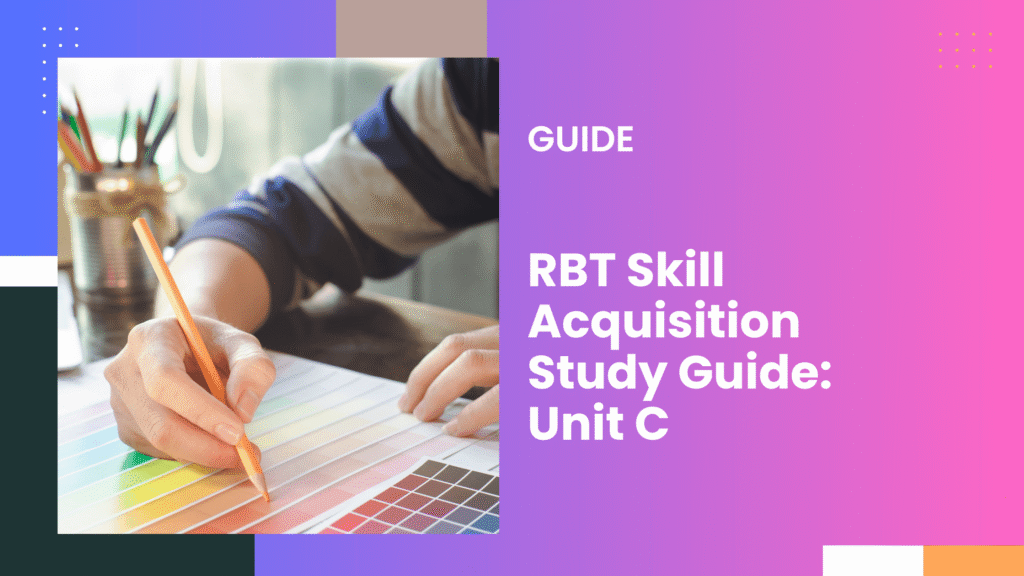
Prepare for RBT Acquisition study guide with in-depth analysis of the latest syllabus to help clear the exam.
You won’t find mastery in memorizing definitions.
Not in behavior analysis anyway. Especially not when you’re standing in front of a child who won’t make eye contact and a data sheet that needs filling.
If you’re working toward your RBT certification, you already know this: Skill acquisition is more than a checklist. It’s where the science meets the moment.
This guide isn’t about how to pass the exam—it’s about how to understand what you’re doing well enough to teach a skill to someone who might never learn it any other way.
1. Start With the Blueprint: The Written Skill Acquisition Plan
You never build without a plan. That’s what a Skill Acquisition Plan (SAP) is: a behavioral blueprint.
Inside, you’ll find precisely defined goals (say, initiating a peer greeting), the materials required, the teaching strategies chosen, and the criteria that mark mastery.
Prompts? They’re included.
Reinforcement schedules? That too.
I want you to think of this document as a contract between design and delivery.
You won’t write the plan, but you will bring it to life. So, every step is there for a reason—your job is to know them well enough to make implementation feel seamless.
2. Preparation Isn’t Optional
I want you to know that if you’re improvising when the session starts, you’re already behind.
Pull the data sheets. Check the targets.
Is the reinforcer still motivating? Has the environment been modified to minimize distractions?
These details seem small—until they aren’t.
And then you’ll realize this the moment a learner refuses to engage, and you’re scrambling to find the right visual or token board.
Preparation isn’t the first step. It’s the step that makes all others possible.
3. Contingencies of Reinforcement
Reinforcement drives learning. But you already know that.
However, understanding the difference between conditioned and unconditioned reinforcement—and when to use each—matters more than any theory can explain.
Let’s say a child is just starting to make (request. You might deliver reinforcement every time—this is continuous reinforcement, ideal when you’re building a new skill from scratch.
Now, let’s imagine that as the behavior stabilizes, you’ll switch to intermittent schedules, perhaps a variable ratio, to keep the behavior strong without making it dependent.
Reinforcement isn’t just a delivery—it’s a decision. This is where you need to make it thoughtfully.
4. Discrete Trial Teaching (DTT)
I know what you are thinking, DTT isn’t glamorous, I know, but it’s effective.
The process is straightforward: instruction, response, consequence. Rinse and repeat.
Sounds mechanical? Yes, it can be—if you’re not paying attention.
But if you do it well, when your pacing is natural and your feedback crisp, DTT becomes something more.
This is the process where you’re not drilling—but you’re shaping instead, and that’s a distinction worth making.
One moment you’re teaching a label. Next session, you’re teaching the learner to tolerate a demand without escape.
So, either way, each trial is a brick in the behavioral foundation you’re helping build.
5. Naturalistic Teaching Technique
Now, just as we have discussed DTT, I want you to imagine the opposite of DTT.
You’re not at a table. You’re on the floor, a toy in hand, and the learner reaches for it. That’s your cue.
Natural Environment Teaching (NET) uses interest as leverage.
So, rather than forcing instruction, you’re just embedding it.
A child wants a snack? Great—prompt the request.
They point to a truck? Model the label.
These moments are brief, spontaneous, and easy to miss if you’re not fully present.
And that’s the trick: You have to be both responsive and strategic—ready to seize opportunities without manufacturing them.
6. Implement Chaining and Task Analysis
It’s like some behaviors can’t be taught in one go.
Brushing teeth. Tying shoes. Making a sandwich.
You break these tasks down, step by step—that’s task analysis.
From there, you choose your approach: forward chaining (start with step one), backward chaining (teach the final step first), or total task (guide the entire sequence each time).
You’re not just teaching a task—you’re building independence.
Every time a learner gains one more step, one less prompt, you’re shifting the balance. That’s real progress.
7. Discrimination Training
Can your learner tell the difference between a red block and a blue one?
Between “sit” and “stand”? If not, you’re missing stimulus control.
Discrimination training ensures responses happen in the presence of specific cues—and not others.
It’s a fine-tuning process. You’re not just teaching behaviors; you’re teaching the when and the where.
Responding correctly is one thing. Doing it consistently, across changing contexts, is another.
8. Stimulus Control Transfer
So, you prompted a correct response. Great. Now what?
If that behavior only happens when you’re there, saying the instruction and gesturing like a flight attendant, it’s not really learned.
Stimulus control transfer is the art of fading yourself out of the equation.
It might start with a full prompt. Then a delay. Then none. The behavior remains, but the cue changes—from you, to the environment. That’s the shift you want.
9. Implement Prompting and Fading
Prompts are powerful. They make learning possible. But if you hold on too long—or fade too fast—you stall independence or foster confusion.
There’s a hierarchy for a reason. Physical. Model. Gestural. Verbal. Visual. Use what’s appropriate for the learner and the task. Then fade deliberately.
Some learners thrive on least-to-most prompting. Others benefit from a more guided start. Know your learner. Adjust accordingly.
10. Generalization and Maintenance
Can your learner perform the skill with a new person? In a different room? Using different materials?
If not, it’s not truly mastered. Generalization isn’t automatic—it’s built into the plan. You might change the SD. Rotate staff. Switch up the setting. Your goal is flexibility, not perfection.
And maintenance? That’s about longevity.
Even when a skill is “mastered,” you revisit it. Otherwise, it disappears quietly and faster than you’d think.
11. Shaping Implementation
Sometimes the target behavior isn’t happening at all. That’s when shaping comes in.
You reinforce approximations—closer and closer versions of the final behavior. It requires timing. Sensitivity. A sense of progress. If you reinforce too early, you stall. Too late, and you frustrate the learner.
One syllable becomes a word. One step becomes a stride. Shaping is slow, but it’s powerful.
12. Token Economies
You’ve seen it before—tokens for behavior, exchanged for rewards.
But a token economy is more than a sticker chart. It’s a carefully managed reinforcement system.
It has rules. Clear targets. Immediate feedback. And—most importantly—a meaningful backup reinforcer.
Eventually, the tokens fade, but the behaviors stick. That’s the design. Reinforcement without dependency.
Too often, RBTs think their job is to follow instructions. And yes, fidelity matters. But if you don’t understand why you’re doing what you’re doing, you miss the chance to become truly effective.
Skill acquisition isn’t about working faster. It’s about working smarter. Understanding what each step is for. Reading the learner. Adjusting without overstepping.
You’re not just a technician—you’re the one who helps learning happen.
And if you’ve read this far, you’re already taking the job seriously, and you can with proper test and guidance, you can pass this exam.
Good luck to you!
